Vol 2 No. 41 TROPIC LIGHTNING NEWS October 16, 1967
Index
| Unit Page | Unit Page | Unit Page | Unit Page |
| 1/5 6 | 1/27 Arty 4 | 2/27 Photo 3 | 3/22 7 |
| 1/5 7 | 1/27 Arty Photos 4 | 2/27 3 | 4/9 1 |
| 1/5 7 | 2 Bde Photos 5 | 2/27 Photo 7 | 4/9 6 |
| 1/5 8 | 2/12 3 | 2/27 8 | 4/23 1 |
| 1/27 3 | 2/12 6 | 2/27 Land Clrng 1 | 4/23 6 |
| 1/27 6 | 2/12 6 | 3rd Bde 3 | 587 Signal Co 6 |
| 1/27 7 | 2/22 6 | 3/4 Cav 1 | 65 Engr. 1 |
| 1/27 8 | 2/27 3 | 3/13 Arty 7 | 65 Engr. Photo 8 |
Villagers Vote Despite VC Threats Of Death
VOTE is a word that the Viet Cong fear. When the ballot is
free the result is always VETO for communism.
The people of Thai My hamlet recently learned how much
"Charlie" hates an impartial election. Local VC warned villagers that
voting would be the same as signing their own death warrant. Even so, 50
percent of the registered voters did vote.
To reward the citizen's defiance of Communist threats, the
government (GVN) promised a shipment of lumber, cooking oil, food, clothing and
toys for the children.
On delivery day a convoy of 10 oxcarts stood waiting at the landing
zone near Phu Cat, about 1500 meters from Thai My. However, by the time
the supply ship arrived with a small group of Vietnamese (ARVN) Regional and
Popular Force troops led by Cu Chi District Chief Captain Ho Van Hiep, the
convoy was nowhere in sight. Hiep and his men found the carts lined up
along the road from Phu Cat to Thai My.
The local chief told Hiep and James P. McKay of Harnell, N.Y.,
District deputy senior advisor, that VC snipers had set up on both sides of the
hamlet. McKay called for support. Within half an hour the call was
answered by the scout platoon of 4th Bn, 23d Inf. "Tomahawks," led by 1LT
Thomas C. Seitzinger of Richmond, Va.
After a quick briefing the Tomahawks closed in with six armored
personnel carriers and blasted away at the enemy. Two hours later the VC firing
ceased. With peace restored, the ox cart drivers drove down to Phu Cat and
picked up the supplies. Because the road was partially underwater few
carts made the plunge without overturning. The 25th Div. soldiers helped
right the carts and escorted the relieved Vietnamese home. Score one more
win for democracy - one more loss for its enemies.
Tunnels, Bunkers And Even Photo Lab Found
U.S. infantrymen and engineers are sweeping through the HoBo Woods
northwest of Saigon destroying a 30-year-old haven for the Viet Cong's 4th
Military Regional headquarters.
Two thousand troops of the 25th Div's 1st Bde began the massive
search and destroy operation Sept. 17 in the Viet Cong stronghold 56 kms from
Saigon.
Searchers have encountered and destroyed four large base camps, 350
bunkers more than eight kms of tunnels and hundreds of feet of trenches.
According to reports, a large number of bunkers were reinforced with concrete
and steel.
Elements of the 65th Combat Engineer Battalion (CEB) have been
working with the infantrymen destroying the enemy fortifications with block
explosives and bangalore torpedoes.
Two major engineering projects are being carried on with the search
and destroy mission. A company of the 65th CEB has upgraded the main
supply route in the northern sector of the area with tons of laterite and
bridging spans.
Elements of the 27th Land Clearing Co, using Rome Plows, are
following behind the infantrymen leveling portions of the dense jungle, at the
rate of 250 acres a day.
The largest tunnel to be found so far was searched by 1LT Jerry
Nations, a platoon leader with the 4th Bn, 9th Inf. from Olympia, Wash.
Nations and three other "tunnel rats" searched a main passageway for a
distance of 10,000 feet before reaching a point that was blocked by fresh dirt.
One hundred meters away from the entrance to the tunnel, probers
found a 55-gallon drum hidden in the heavy brush containing 20,000 rounds of
Chinese 7.92mm ammunition.
The list of captured equipment found in a bunker complex included a
photo enlarger, photographic chemicals, printing paper, cameras and film.
A few days earlier another bunker was uncovered that contained what
officials termed "a very complete printing shop." Extracted were two
printing presses, 800 pounds of type - both English and Vietnamese letters, and
a large quantity of paper.
Putting the facts together, officials are certain that the area was
the propaganda headquarters for the Hau Nghia-Saigon sector.
To date, searchers have evacuated more than 69,000 pounds of rice
and destroyed hundreds of grenades, mortar and artillery shells and individual
weapons.
The operation has two major missions according to Col. Edwin H.
Marks, brigade commander from Alexandria, Va.
"To eliminate the Viet Cong forces based there, and secondly, to
remove the dense cover the woods afford, depriving the enemy of any further use
of his former refuge.
Huge Monthly Leaflet Drop
Psychological operations officers of the 25th Inf Div's 2d Bde
reported recently that more than 24 million leaflets were dropped during
September in support of the unit's Operation "Kolekole."
Most of the massive drops included standard Chieu Hoi and safe
conduct passes for rallying Viet Cong.
But MAJ Donald Royal, psychological operations officer from
Chattanooga, Tenn., says that many were tailor made to inform the Vietnamese
civilians of specific combat incidents.
"After major brigade victories and Viet Cong atrocities against
the civilians we try to tell the story through leaflets," said Royal.
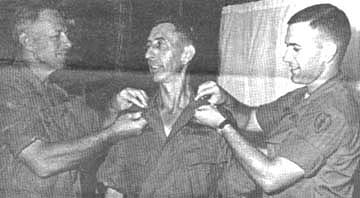 |
NEW GENERAL - BG William T. Gleason has his new stars pinned on his collar by MG F. K. Mearns (left), 25th CG, and 1LT James R. Murphy, Gleason's aide. BG Gleason is one of two assistant division commanders. |
Assistant 25th Div Commander
Promoted To Brigadier General
William T. Gleason, assistant 25th Div commander, was promoted to
brigadier general Sept. 28. BG Gleason joined the division in August.
He was previously assigned to MACV headquarters as deputy assistant chief of
staff for Logistics.
MG F.K. Mearns, division commander, pinned the stars on Gleason's
shoulder in a late-evening ceremony.
A 1941 graduate of the U.S. Military Academy at West Point, he has
attended the Command and General Staff College, the Armed Forces Staff College
and the Industrial College of the Armed Forces.
BG Gleason is a veteran of World War II and the Korean War.
Among his awards are the Silver Star, Legion of Merit and Bronze Star with oak
leaf cluster.
Mrs. Gleason lives in Prince George, Va., with their 12-year-old
son, William T. III. Both their daughters, Susan and Emilie, are attending
college.
Men Needed For 25th's LRRP Det
Enlisted and officer personnel are being sought for a Long Range
Reconnaissance Patrol (LRRP) Detachment being formed by the 25th Inf Div.
Volunteers will make up the LRRP Detachment, assigned to the 3d
Sqdn, 4th Cav.
Desirable prerequisites for the volunteers are: Ranger Recondo
School, Jungle Training School; excellent physical condition; above average
knowledge of map reading and at least eight months left in the command, unless
the volunteer is Recondo School trained with six months remaining on his tour.
Two armor or infantry lieutenants are needed to be LRRP leaders.
They must have at least one month of combat experience and seven months
remaining on their present tour.
Officer interviews may be arranged with the G1, Cu Chi 101/121 or
Lightning 1.
Required for patrol from enlisted personnel are: six E-6 to be
patrol leaders, 24 E-4 to be IS radio operators; and eight E-5 to be assistant
patrol leaders.
In the communications section there is a need for one E-5 as chief
RTT operator; one E-5 as senior field radio repairman; one E-4 to be a field
radio mechanic, eight E-4 as IS radio operators; and two E-4 to be RTT
operators.
Interviews for volunteers with the grade and MOS for the enlisted
openings may be arranged by contacting the chief of the AG Personnel Management
Division, Cu Chi 229.
Page 2 TROPIC LIGHTNING NEWS October 16, 1967
Decorated
The American people desire, and are determined to work for,
a
world
in which all nations and all peoples are free to govern
themselves as they see
fit and to achieve a decent satisfying life.
HARRY S. TRUMAN
| SILVER STAR | |
|
CPT Thomas J. Lewman, Co A, 4th Bn, 9th Inf SGT Melvin E. Trotter, Co B, 3d Bn, 22d Inf |
SP5 Eugene Whiting, Co B, 25th Avn Bn SP4 James K. Wheeler, Co A, 2d Bn, 14th Inf |
DISTINGUISHED FLYING CROSS |
|
| CPT Billy R. Vinson, D Trp, 3d Sqdn, 4th Cav | |
SOLDIER'S MEDAL |
|
| PSG Kenneth D. Black, Co A, 1st Bn, 27th Inf | |
BRONZE STAR (VALOR) |
|
|
1LT Michael R. Tarantola, Co A, 2d Bn, 27th Inf 1LT Brooks E. Remencus, Co C, 2d Bn (Mech), 22d Inf 2LT John J. Ricca, Co A, 2d Bn, 14th Inf 2LT David R. Benites, Co A, 2d Bn, 27th Inf SSG Nelson Morales-Irizarry, A Trp, 3d Sqdn, 4th Cav SSG Gary White, Co B, 1st Bn (Mech), 5th Inf SGT Ronald D. McIlravy, A Trp, 3d Sqdn, 4th Cav SGT Daniel T. Hollister, HHC, 2d Bn (Mech), 22d Inf |
SGT Richard R. Lamothe, Co E, 65th Engr Bn SGT Roger W. Thompson, Co B, 1st Bn (Mech), 5th Inf SGT Joseph S. Vann, Co B, 1st Bn (Mech), 5th Inf SGT Walter E. Knorek Jr., Co A, 2d Bn, 14th Inf SP4 Joseph Frye, Co B, 1st Bn (Mech), 5th Inf PFC Allan W. Franklin, Co B, 1st Bn (Mech), 5th Inf PFC Francis Balchaitis, Co A, 2d Bn (Mech), 5th Inf PFC Allen A. Peel, A Trp, 3d Sqdn, 4th Cav |
BRONZE STAR (MERIT) |
|
|
MAJ Francis X. Delvy, D Trp, 3d Sqdn, 4th Cav CPT Richard Craig, HHC, 3d Bde CPT Jerry W. Smith, HHC, 2d Bn, 12th Inf CPT Frederick C Phillips, HHC, 1st Bde CPT Philip Blackwell, 9th Cml Det 1LT Ernst H. Simmons, Co B, 2d Bn, 14th Inf 1LT Richard H. Graham, HHC, 65th Engr Bn 1LT Donald C. Moore, B Trp, 3d Sqdn, 4th Cav 1LT Jesse O. Pearce, Co A, 4th Bn, 9th Inf W01 James R. Moore, HHC, 1st Bde MSG Elmer Neely, 25th Admin Co SSG Robert E. Connor, HHC, 25th Inf Div SSG Larry D. Clift, Co B, 2d Bn, 27th Inf SSG Donald E. Ahrens, HH&S Btry, 7th Bn, 11th Arty |
SSG George W.
Milligan, Co C, 2d Bn, 27th Inf SSG James A. Presley, Co A, 2d Bn, 27th Inf SSG Floyd Young, HHC, 1st Bn (Mech), 5th Inf SGT Richard F. Dominak, C Btry, 2d Bn, 77th Arty SGT Timothy W. Helton, HHC, 3d Bn, 22d Inf SGT Alvarado Rodriguez, Co B, 4th Bn, 9th Inf SP5 Allan Biggs, Co B, 1st Bn (Mech), 5th Inf SP5 Thomas C. Zito, HHC, 3d Bn, 22d Inf SP5 Gabriel D. Yantez, HQ & Co A, 25th Med Bn SP4 Jesus P. Babauta, Co C, 1st Bn (Mech), 5th Inf SP4 Phillip D. Clifton, Co A, 2d Bn, 27th Inf SP4 John W. Ellery, Co B, 1st Bn, (Mech), 5th Inf SP4 Charles D. Mayer, HHC, 2d Bn, 27th Inf |
ARMY COMMENDATION MEDAL (MERIT) |
|
|
CPT Edward A. Burton, Co B, 25th Med Bn CPT Charles L. Reynolds, 25th MI Det 1LT Ronald G. More, HHC, 2d Bn, 12th Inf PSG Eulogio Dabin, Co C, 2d Bn, Inf PSG Tsuzuki Kimura, Co B, 2d Bn, 12th Inf PSG Jeff R. Price, Co B, 2d Bn, 12th Inf SSG Kenneth Spadley, C Trp, 3d Sqdn, 4th Cav SSG Charles D. Graham, Co A, 2d Bn, 12th Inf SGT Jesse L. Williamson, Co B, 3d Bn, 22d Inf |
SGT Olis G. Cole, Co B, 2d Bn, 12th Inf SGT Ruben Alaniz, Co B, 2d Bn, 12th Inf SGT Gile Cochran, Co B, 2d Bn, 12th Inf SGT John M. Mayer, B Btry, 2d Bn, 77th Arty SP5 Ronald D. Cash, 25th MI Det SP5 Clifford W. Tennison, 25th Admin Co SP4 Larry Ward, Co B, 3d Bn, 22d Inf SP4 Patrick Leintz, HHC, 25th S&T Bn SP4 Jewel W. Sanford, HHC, 25th S&T Bn |
Reasons For Terror Tactics
PART II
Last week in the Tropic Lightning News, two of the Viet Cong's
reason for terror were given. This week the remaining three reasons will
be given.
Disorientation and Psychological Isolation
The Viet Cong use disorientation and psychological isolation of the
individual. This is done by destroying the structure of authority which
previously was a source of security. The particular target is the
Vietnamese
villager. The response which the Viet Cong seek by
using terror is fright, anxiety and despair. Terror removes the
underpinnings of the orderly system in which the villager lives out his life.
It disorients the villager by demonstrating to him that his government cannot
give him the safety and order he normally expects from it.
On a much deeper level, the Viet Cong seek to isolate the villager
from his social context. Terror isolates a villager. He can no longer draw
strength from customary support, he can rely only on himself. He may be
physically undisturbed but he is terribly alone in his anguish. Villagers
then become impotent and of no threat to the Viet Cong.
Elimination
Elimination of opposing forces is the chief utility of Viet Cong
terror. By means of terror the Viet Cong have sought to eliminate the
entire leader class of Vietnamese villagers.
Terror is also used to immobilize the GVN officials remaining
between the Viet Cong and their domination of the rural area. For this
reason there has been relatively little terrorism in Saigon and virtually none
directed at top level government officials.
Provocation of the GVN
In the early years Viet Cong terror acts were committed with the
express purpose of provoking reprisals, but the practice was not as widespread
as in other insurgencies. Any government faced with terrorism must attempt
to suppress the terrorists. Ideally, that suppression is by an orthodox
use of law enforcement. But if the terrorist is effective and if the
government sees itself in a crisis, it will almost inevitably use extraordinary
repressive measures.
Only 15 Days Left
Win Cash Prizes
Who would like to win $1,000? Or $100? Or even $50?
The chances of doing so are excellent for the man or woman in the
U.S. Military willing to take a few minutes to write a letter on the subject of
freedom.
The event is the annual Freedoms Foundation contest for U.S.
servicemen and women on active duty and the topic is "Freedom - My Heritage,
My Responsibility."
There are 101 prizes offered in the contest worth a total of
$8,500. The top entry earns $1,000, the next 50 earn S100 and the next 50
win $50. Each winner also receives a George Washington Honor Medal.
How do you go about it? Write a letter, essay or poem on the
subject of this year's contest. Enter as many times as you want but each
entry must be no less than 100 and no more than 500 words in length.
Be sure each entry includes your typed name, rank, serial number,
branch of service, complete unit address and permanent home state address and
ZIP code.
Mail your entry to Freedoms Foundation, Valley Forge, Pa. 19481,
before Nov. 1, 1967.
The winners will be announced Feb. 22,1968, at Valley Forge.
APO Announces Mailing Periods
Here are the recommended mailing periods for packages sent to CONUS
from Vietnam during the 1967 Christmas season:
Surface Mail - Oct. 1 to Nov. 1.
Space Available Mail (SAM) - Nov. 15 to Dec. 4.
Airmail - Dec. 1 to Dec. 13.
For parcels going to Hawaii the recommended mailing periods are:
Surface Mail - Nov. 1 to Nov. 20.
SAM - Nov. 15 to Dec. 4.
Airmail - Dec. 1 to Dec. 13.
To Pacific APOs:
Surface Mail - Nov. 15 to Dec. 4.
SAM - Nov 15 to Dec. 4.
Airmail - Dec 1 to Dec. 13.
And to New York APOs:
Surface Mail - Oct. 15 to Nov. 1.
SAM - Nov. 15 to Dec. 1.
Airmail - Dec. 1 to Dec. 10.
Business "As Usual" In Hong Kong
SAIGON (MACV) - Servicemen spending their R&R in Hong Kong are
"resting and recuperating" as usual, MACV officials said recently.
Since the partial curfew on the night of July 12, there have been no
restrictions placed on individuals on leave or R&R in the British Colony.
U.S. Servicemen returning from the area report that all systems
that make R&R trips "go" are functioning normally; local tours, both
water and land, are running on schedule; the shopping centers are operating and
the night clubs are open and swinging every night until 2 am.
Military R&R officials in Hong Kong stated that the program has
been unaffected by incidents in the area and that the city remains a shopper's
paradise which offers bargain prices for tailor-made clothes, cameras and all
types of electronic equipment. It is a once in a lifetime chance for
servicemen to enjoy this oriental city while resting from the rigors of war, the
officials said.
The TROPIC LIGHTNING NEWS is an authorized publication of the 25th Infantry Division. It is published weekly for all division units in the Republic of Vietnam by the Information Office, 25th Infantry Division, APO San Francisco 96225. Army News Features, Army Photo Features, Armed Forces Press Service and Armed Forces News Bureau material are used. Views and opinions expressed are not necessarily those of the Department of the Army. Printed in Tokyo, Japan, by Pacific Stars and Stripes.
Maj.Gen. F. K. Mearns . . . . . . . . . . . Commanding General
Maj. Bernard S. Rhees . . . . . . . . . . . Information Officer
1Lt. Larry Rottmann . . . . . . . . . . . . . Officer-in-Charge
SSgt. David G. Wilkinson . . . . . . . . Editor-in-Chief
SP4 Dave Cushman . . . . . . . . . . . . . Editorial Assistant
Page 3 TROPIC LIGHTNING NEWS October 16, 1967
Enlistment Debasement Fails, Both Brothers Join The Army
It isn't really too unusual that SP6 Marvin Cole packed six and
one-half years of medical education into three years at an experimental medical
school.
What is unusual is that with all that training, Cole today is
serving as a combat medic with the 25th Inf Div, and he likes his work.
Cole, a native of Clarksville Tenn., was near graduation from a
special out-of-country medical school when a severe automobile accident put him
in the hospital for nine months.
Shortly after he walked away from the hospital he received a
telephone call from his mother asking him to please come home and talk his
younger brother out of joining the Army.
He failed so miserably that soon after they both joined up.
With his extensive medical training, he was made an instructor at
the Army's basic medical corpsman school at Fort Lewis, Wash. He then
spent three years in Japan where he met and married his wife.
Today, Cole is serving as a senior combat aid man with the 2d Bn,
27th Inf "Wolfhounds." Two of his former students are serving with
him.
He says that completion of medical school is his primary ambition
but he also wants to stay in the service. "If the Army will help me get
my degree," he says, "I'll spend thirty years in the Army."
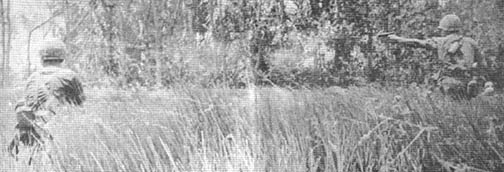 |
| SNIPER! - Two infantrymen from the 2d Bn, 27th Inf "Wolfhounds," take a Viet Cong sniper under fire during a sweep in Hau Nghia Province during Operation "Kolekole." (Photo by SP4 Joe Carey) |
Wolfhounds and Warriors
New Battalion Commanders
New 'Wolfhound'
"Wolfhounds" of the 25th Inf Div's 2d Bn, 27th Inf, kept up
their tradition of changing commanders under combat conditions recently, as LTC
Walter E. Adams accepted the unit's colors from LTC Edward Peter.
The ceremony took place in a large field southwest of the
division's Cu Chi base camp at the battalion's night position. As the
remainder of the unit formed to witness the change-over, one company manned
machineguns and rifles, securing the perimeter.
LTC Adams, a 1950 West Point graduate said, "I am extremely proud
to take command of the 2d Wolfhounds. This is a unit with a proud heritage
and enviable combat record. We will maintain it."
The new commander holds the Bronze Star Medal with oak leaf
cluster, Army Commendation Medal with oak leaf cluster, Purple Heart, Combat
Infantryman's Badge and Senior Parachutist's Badge. He has attended
the Infantry Advanced Course, Command and General Staff College Armed Forces
Staff College, and National War College. He holds a master's degree in
International Affairs from George Washington University.
He has served as a platoon leader with the 279th Inf in Korea, as a
White House aide from 1953-56, as commander of the 1st Bn (Airborne), 503d Inf,
on Okinawa, and as a projects officer in Bangkok, Thailand.
LTC Adams is married and has three children.
New 'Warrior'
DAU TIENG - In a brief ceremony conducted at Battalion
Headquarters, 2d Bn, 12th Inf, LTC R. D. Tice assumed command of the "White
Warriors," succeeding LTC James F. Greer.
During the ceremony, COL Kenneth E. Buell, commander of the 3d Bde,
25th Inf Div, commended LTC Greer on his outstanding performance as commander of
the 2/12 and welcomed LTC Tice as the new battalion commander.
LTC Tice volunteered for his current tour in Vietnam and brings to
the battalion a varied and distinguished career. His former service
includes duty as an infantry platoon leader, company commander, and as G-3
advisor with the MAAG in Vietnam. He has served on the Army General Staff
and has had a tour of duty as the Joint Staff at USSOUTHCOM, the Unified Command
located in the Canal Zone. During the past two months LTC Tice has served
as the deputy commander of the 3d Bde, 25th Inf Div. His past overseas
tours have taken him to Europe, Vietnam, Central and South America and now back
again to Vietnam.
Among the awards LTC Tice has received are the Legion of Merit,
Army Commendation Medal with oak leaf cluster and the Combat Infantryman's
Badge.
Viets No Stranger To Game Of Soccer
DAU TlENG - It was obvious to the Americans present at the first
soccer game played at Dau Tieng in several years that the Vietnamese were no
strangers to the sport.
Playing on the recently refurbished soccer field in the heart of
the village, 105 kms northwest of Saigon, the gold-shirted military team,
composed of members of the RF-PF foms defending the village, were hard pressed
by the blue-shirted civilians who won the match 3-0.
A Sunday crowd of about 700 fans lined both sides of the field as
the chief of Tri Tam District, CPT Phan Manhtuan, booted the sphere to begin the
game.
The civilian team immediately took charge of the ball, and most of
the contest was played in the vicinity of the military goalie who was kept busy
stopping the drives of the aggressive civilian forwards.
Teamwork highlighted the play of both sides as the two teams kept
their composure throughout the hard-played duel. Accurate passing and
fancy footwork showed the skill of the Vietnamese players as they raced up and
down the once forgotten soccer field.
The re-emergence of soccer in Dau Tieng can be credited to the
efforts of the 3d Bde, 25th Inf Div, Civil Affairs Team and the cooperation of
the village officials.
Seeing what used to be the home of the champion soccer team in all
of Vietnam being used as a pasture for pigs and cows, 2d LT Charles Wray of
Pamona, Calif., of the 2d Civil Affairs Co, asked the village officials what his
office could do to put the field back in shape and get a soccer program started
in the village.
Remembering some of the great soccer teams in Dau Tieng's past,
the response was enthusiastic. The soccer field was cleared of the cows
and pigs, the grass was mowed, the fence encircling it was repaired and
repainted. The faltering goals were strengthened and new nets were added
behind them.
For equipment, soccer balls and complete uniforms including shorts,
shirts of several different colors for the various teams, socks and soccer shoes
were acquired by the Civil Affairs Team.
An old member of those teams in Dau Tieng's past volunteered to
coach the teams which are set up on an age level basis. At present there
are five different teams in Dau Tieng practicing the world's most popular
sport. Each Sunday, the teams are paired off and the action begins.
In the first game, the new shoes seemed to be giving the players
some trouble. Several players were seen discarding the shoes about halfway
through the contest.
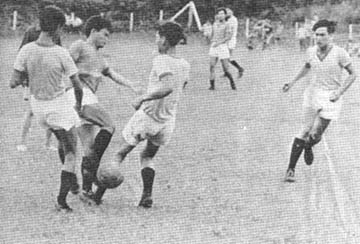 |
OUCH - Flying feet highlight a hard-played soccer game at Dau Tieng. The civilian team defeated the military by 3-0. (Photo by 1LT Ralph Campbell) |
Slang Term's Meaning True
Infantryman slang in Vietnam talks about "bringing smoke on the
Viet Cong." A 25th Inf Div unit did just that recently with excellent
results.
Two armed VC soldiers ran from their hiding place as Bravo Co, 1st
Bn, 27th Inf, "Wolfhounds," approached. The two streaked across a
small field and disappeared into a tunnel.
When they refused to come out, in went two smoke grenades.
After a few breaths of the brightly colored smoke the VC burst out of the
entrance firing. Return fire killed one and wounded the other.
Page 4 TROPIC LIGHTNING NEWS October 16, 1967
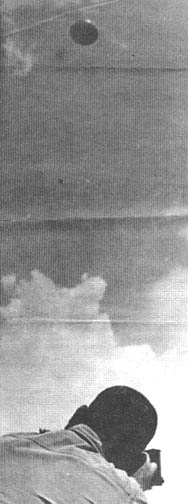 'Metro' Computations Valuable To Artillery
'Metro' Computations Valuable To Artillery
Story and Photos by 1LT Ralph Campbell
DAU TIENG - Gathering the information needed for a "Met
message' is the mission of the Meteorological Section of the 1st Bn, 27th
Arty, stationed with the 3d Bde., 25th Inf Div, at Dau Tieng.
To the infantryman, rain, wind and heat are just a few of the
obstacles he encounters as he pushes through the jungles in search of the
elusive enemy. These same conditions in a different way are also obstacles
to the artillery which supports the ground soldier.
Variations in temperature humidity, winds and atmospheric pressure
effect the flight of the big gun's projectiles - several hundred meters long,
short, left or right, depending on the range being fired. For an infantry
soldier who needs supporting fires a few hundred meters to his front, these
weather-influenced variations could mean the difference between life and death.
Through computations which are standardized throughout the free
world an artillery battery can compensate for the changes in the weather when
they receive a NATO Meteorological Message. This message includes the
winds and temperature at different altitudes in the atmosphere.
Four times a day, a balloon filled with hydrogen gas carries a
miniature radio transmitter, called a radiosonde high into the atmosphere.
Signals are received from this airborne weather station at heights of up to
100,000 feet and distances of 200 kms.
Within the radiosonde are elements which measure the temperature
and humidity at the various altitudes. These sensings are transmitted
through the radio transmitter which is contained in the compact unit and are
received on the ground by a Radwin Set which resembles a radar antenna.
The Radwin Set automatically locks in on the signal from the
radiosonde and follows it until the balloon bursts or the transmitter is out of
the 200 kms range of the unit.
To determine the speed and direction of the winds, the elevation
and deflection of the Radwin Set are fed into a computer which prints out the
information, as the flight progresses. The data received from the sensors
in the radiosonde is also printed on the sheet to correspond with the altitude
of the balloon.
From the data received, the "Met message" is compiled by the
"human computers" of the section and sent to every artillery unit located in
the area. A copy is also sent to higher headquarters to be used in a
composite weather picture for the entire country of Vietnam.
Operating as an independent unit, a meteorological section must be
able to move all its equipment to some location in a forward area and be
prepared to compute a "Met message" within 90 minutes after arrival at the
new location.
Maintenance of the delicate electronic equipment plays an important
part in keeping the data up-to-date.
"I have been with meteorological sections in Europe and
Alaska," says WO Paul Nienaber of Madison, Wis., the head of the section,
"and wherever I go, I always take my own tools and manuals with me for
maintenance.
"Several days ago, a switch on the Radwin went out," he
continued. "The switch has sixteen different connections which all had
to be re-soldered when we replaced it. The heat and humidity here are very
hard on the equipment and we have to keep up the maintenance or we would not be
operating half the time."
There are some elements of danger connected with the operation of a
Met section. The section produces its own hydrogen gas by combining
calcium hydride and water. The resulting gas is extremely volatile and
explosive.
"One time in another unit," related Nienaber, "I was in the
area when some of the gas accidentally blew up and threw a man 20 feet from
where he was standing."
In the 17-man section, each individual has received extensive
training in either meteorology or in radio-teletype operations. According
to Nienaber, the course consists of four months of extensive training in
electronics at Fort Sill, Okla.
The next time an infantryman in the Dau Tieng area is pinned down
and needs artillery fast he can thank the meteorological section for providing
the weather data to the firing battery which put those needed rounds a few
hundred meters to his front.
(Above, right) As a balloon begins its ascent, SFC Bobby
Burden, the Metro
station chief, follows the progress visually using a theodolite. In the
event of electrical failure or breakdown, the visual method can be used to
determine wind strength at various altitudes.
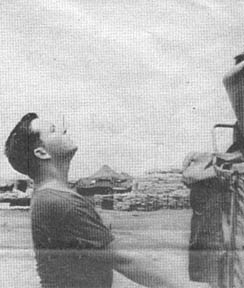 |
Checking the operation of the Radwin Set, SP4 Raymond Magers watches the flight of the balloon. The Radwin Set automatically locks on the signal from the radiosonde beneath the balloon and follows it until out of range or until the balloon bursts. |
| WO Paul Nienaber (right) checks SP4 Raymond Magers as the data is recorded on the radio sound recorder during a balloon flight. The information is then recorded on charts. | 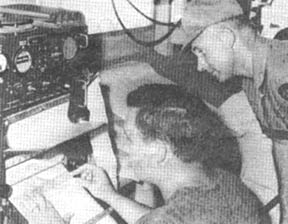 |
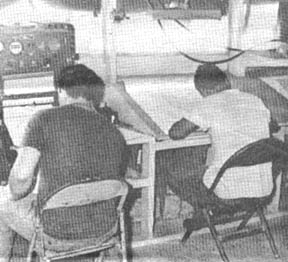 |
The information goes from left to right as it is printed out on the radio sound recorder at the left and then recorded on charts to the right. Working are SP4 Raymond Magers (left) and PFC Frank Pyeatt. |
Page 5 TROPIC LIGHTNING NEWS October 16, 1967
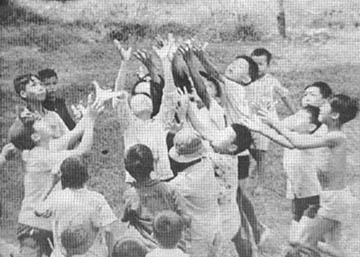 |
Get it! Everyone reaches for the ball during a game of volleyball. |
| Making children happy is the order of the day, and civil affairs soldiers put their all into it. | 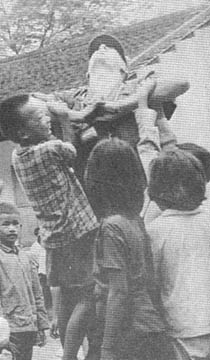 |
A Mid-Autumn Festival, Trung Thu Is For Kids
PHOTOS BY SP4 BRUCE DAPPRICH
Trung Thu is a whole day in Vietnam dedicated to the kids.
It's the annual mid-autumn festival, generally known today as the Children's
Festival.
On Trung Thu the kids are king as these pictures from the hamlet of
Tan Hoa show. Civil Affairs soldiers of the Div's 2d Bde were on hand to
make sure the celebration was a success.
Traditionally, the Vietnamese observe Trung Thu on the 15th day of
the eighth lunar month. Both adults and children take part, but the
emphasis is on the youngsters.
Parades, singing and dancing go on all day long and far into the
night. The children are allowed to stay up long past their normal bedtime.
Many of them stay up to play with new gifts, all of them brand new
as tradition demands.
How did it all begin? One story says the ancient Emperor
Duong Minh Hoang was inspired by the beauty of the mid-autumn season and wished
to visit his sister the moon.
With the aid of a magician the emperor climbed a golden bridge to
the full moon where he received a royal welcome.
When he returned to earth he decreed that the night on which he
visited the moon should forever be a time of joy and celebration, especially for
the young - and so it has been.
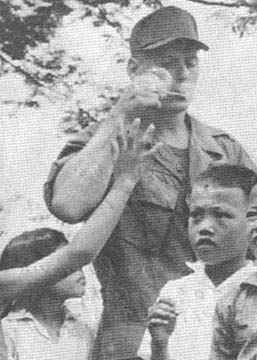 |
Soap bubbles are a delightful first for most of the festival kids. |
| Let me in! Everyone wants a place in front when toys are given out. | 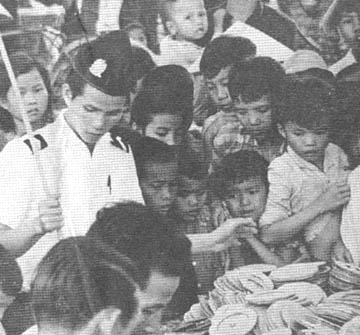 |
Page 6 TROPIC LIGHTNING NEWS October 16, 1967
2400 Calls Daily Keeps Plt Busy
DAU TIENG - Handling over 2400 calls per day, the men of the White
Platoon, 587th Sig Co, provide area communications for the 3d Bde, 25th Inf Div.
Activated for duty in the Republic of Vietnam in January of 1966,
the advance party of the signal platoon arrived at Dau Tieng in March 1967.
According to platoon leader Charles Coleman of Miami, the 99
enlisted men of the White Platoon transformed a stand of aging rubber trees into
a self contained communications installation with virtually no outside help.
All communications centers were built from the ground up and
completely sandbagged. n extensive system of personnel bunkers, orderly
and supply rooms and an EM-NCO club complete the platoon area.
To handle the tremendous volume of incoming calls, the men of the
White Platoon work in three shifts.
SFC Harold Dupuis of Lake Sinden, Mich., platoon sergeant, stated
that his men must successfully complete an eight-week course in carrier or radio
relay operations in order to maintain an installation which cost more than
$200,000 to install.
Sgt Re-ups, Decorated
DAU TIENG - A ceremony held here recently had a double significance
to SFC Tsuzuki Kimura of Kahului, Maui, Hawaii, when he received both the Bronze
Star with V-device and reenlisted for another three years.
LTC R. D. Tice, commanding officer of the 2d Bn, 12th Inf, 3d Bde,
25th Inf Div, presented the award only a short while after the reenlistment.
Kimura was cited for heroism while his unit was protecting a fire
support base which was attacked by mortar fire and ground forces. During
the battle SFC Kimura led his men and personally directed mortar fire onto the
enemy's position which enabled the company to repel the attack and silence the
enemy's mortars.
During the ceremony SFC Kimura was also awarded the Army
Commendation Medal for service and the Vietnamese Cross of Gallantry with gold
star.
Little Kindness Goes Long Way
Two orphaned Vietnamese sisters repaid the kindness of U.S.
infantrymen with eight lifesaving gifts.
The sisters, ages eight and eleven, walked into the 4th Bn 23d
Inf's night position late in the afternoon.
"They were just in time for some hot chow," says CPT William W.
Hartzog, Charlie Co commander from Jacksonville, Fla., "so our ARVN
interpreter took over and fed the youngsters."
Later that evening the interpreter learned from the sisters that
both parents had been slain by the Viet Cong. Early the next morning the girls led a patrol to a field
where probers found eight anti-tank mines.
| A LOT OF BULL - The saying is "grab the bull by the horns," but in this case the tail seems better as the 25th Inf Div veterinarian attempts to give this ox a shot of harmless tranquilizer. (Photo by SP4 Jack Mrax) | 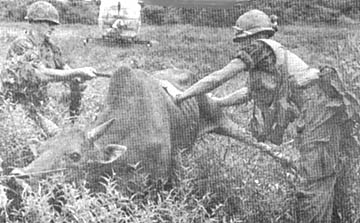 |
Viet Cong Left In The Cold When Viet Hamlets Relocated
DAU TIENG—Southeast of the huge Michelin Rubber Plantation, the
tiny villages of Ben Tranh, Van Huong, and Tra Ginh served for many years as a
stopping point for Viet Cong supply trains as they moved northward into War Zone
C.
Within these tiny hamlets, the Cong were safe. They knew that
the U.S. artillery and bombers would not decimate a civilian village.
Recently, a combined operation of the 3d Bde, 25th Inf Div, and
Vietnamese personnel relocated 334 men, women and children along with their
oxen, chickens, dogs, and all their household goods to the resettlement area at
Lai Thieu just outside of Saigon.
The operation began early in the morning with loudspeaker
broadcasts from a UH-1D helicopter and a U-10 airplane which instructed the
people that they were going to be moved, why the move was necessary and a short
description of the area to which they were going. Also, some 170,000
leaflets were dropped which explained the relocation procedures and showed a
picture of the new area.
In a landing zone near the area, the 2d Bn, 12th Inf, which was
lifted into the area by forty troop carrying helicopters, began a move toward
the villages while the 2d Bn (Mech), 22d Inf, in Armored Personnel Carriers (APC's)
followed the ground troops.
With each company of United States troops there was a composite
team of nineteen Vietnamese. Each team consisted of four members of the
Police Field Forces, one man from the National Police, four psychological
operations men, six soldiers from the 5th ARVN Division who were specially
trained in this type of operation, two men from the Tri Tam District
intelligence squad, one Chieu Hoi worker, and an officer-in-charge.
When the people were assembled, the big Chinooks began to evacuate
them to Lai Thieu. The only problem with the move came with the oxen which
were to be taken with the refugees. This was solved by the division
veterinarian who, despite several near misses from flying hooves, managed to
give each animal a harmless tranquilizer before it was loaded onto the chopper.
One old man who had lived in the area for his entire life gathered
his worldly possessions together and happily boarded the chopper. He said
a few words of Vietnamese as he entered which, when translated meant, "I am
glad to go." This is a man the VC tax collectors will not see again.
VC Are Ambushed Same Place Twice
It was a busy night for the 25th Inf Div ambush patrol; two
different ambushes with enemy contact both times in the same location.
The sixteen-man patrol left the 1st Bn (Mech), 5th Inf, forward
base camp just as darkness began to set in.
"It was supposed to be a roving patrol," explained 2LT Jerry
Yasher, a platoon leader from Greensburg, Pa. "We were prepared, though,
to set up a hasty ambush."
As the patrol crept silently along a woodline bordering a wide rice
paddy, the point man heard noises to the front.
"It sounded like people walking in the water," said SSG Osia
Ferbbee, a squad leader from New York City. "We immediately set up an
ambush and waited."
Fifteen minutes later three armed VC walked right into the trap and
were killed by machine gun and grenade fire.
"It was beautiful," said Ferbbee, "just like in the book."
The patrol returned to the base camp for ammunition re-supply and
at one o'clock in the morning, they set out again.
Just after passing through their earlier ambush site the point man
again spotted enemy, this time a group of 25 armed VC, all walking toward them.
The platoon leader directed the men back where they set up, exactly
in their first ambush position. Once in position they wasted no time and
called in artillery and mortar fire.
"They kept getting closer and closer," said rifleman PFC Earl
Mack of Cambridge, Md., "so we opened up with rifles and grenade launchers."
The VC withdrew leaving behind many blood trails and several pieces
of blood stained clothing. The patrol returned again to their base.
"It was a long, busy night," said Yasher, "but I just hope we
don't have another one like it again."
Maybe VC Swim In All That Rice?
The Viet Cong operating in Tay Ninh Province near Trang Bang are
apparently swimming in rice.
While searching a small hamlet, Alpha Co of the 4th Bn, 9th Inf,
led by a rallier, found 500 pounds of rice hidden under a haystack.
Continuing the search, the 25th Div element found two huts - each
containing a ton of rice in what was described by one soldier as being
inflatable swimming pools.
Not All Things Good With. . .
In Hau Nghia Province, things don't always "go better with
Coca-Cola."
U.S. 1st Bn, 27th Inf "Wolfhounds," slashed their way into a
small clearing recently 32 kms, northwest of Saigon. In the center sat an
apparently un-opened cola can with a long string coming from the bottom.
Taking one last thirsty look a 25th Div infantryman pulled a
grenade pin and blew the can sky high.
The explosion left a crater twice as big as expected.
Demolitions men said it was a booby-trap probably filled with gunpowder.
Page 7 TROPIC LIGHTNING NEWS October 16, 1967
Spiders Too Much For This 'Crawler'
A 25th Inf Div tunnel rat thought twice about entering a Viet Cong
tunnel during a 2d Bde search operation northwest of Saigon. The walls and
floor were covered with huge spiders.
"We swept through a small hamlet and came across a deserted
hootch," said SP4 Larry Ranier, a rifleman with the 1st Bn (Mech), 5th Inf.
"Someone found a tunnel running out of a sleeping bunker and I
volunteered to check it out," he said. Ranier, a native of Davis,
Calif., borrowed a flashlight and started to enter the tunnel. He was back
out in a split second.
"Spiders half the size of my fist were everywhere," he told his
company commander. This time, armed with a bamboo stick he reentered the
tunnel. The spiders all scurried to the far end.
"A few ran at me and I killed them with the stick, but when I got
to the end the rest were waiting for me. Before I knew it I was completely
covered with them. They were whizzing by me in all directions," he said.
The tunnel branched off to a secret exit and Ranier headed for it
as fast as he could move, killing spiders as he went.
"You can believe I was glad to get out of there," he said
later, "there just wasn't room in there for all of us."
Too Close For Comfort
DAU TIENG - During the 25th Div's Operation "Kunia" recently
a recon patrol turned up a quick find for SGT Heriberto Escamilla of McAllen,
Tex., and the third platoon of Co D, 3d Bn, 22d Inf.
Not more than forty yards outside of the battalion perimeter the
patrol discovered a well-stocked camp used by VC regulars.
Warm food pots indicated the VC had been there the night before.
| CAUTIOUSLY - A patrol of the 2d Bn, 27th Inf "Wolfhounds," fights its way through jungle growth 56 kms northwest of Saigon during the 25th Inf Div Operation "Kolekole." (Photo by SP4 Joe Carey) | 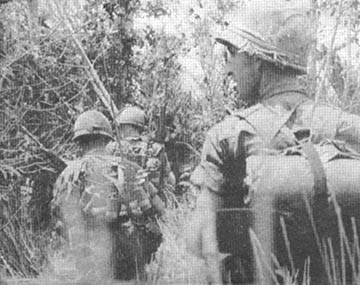 |
Reward For Boobytraps Plan Is A Life Saving Project
Can you buy a limb or a life? Intelligence officers of the
25th Inf Div's 2d Bde are convinced of it.
Working in heavily booby-trapped Hau Nghia Province, they are
making extensive use of giving cash rewards to Vietnamese who point out Viet
Cong mines and boobytraps.
Prices range all the way from 500 piastres for a small trap to
20,000 piastres for a tank-smashing mine.
"In an area where spotting explosive mines and traps can mean
life or death for the infantryman, we feel the money is well invested," says
MAJ Lynn Steverson, Bde intelligence officer.
The program proved its worth recently when in a few days, three
villagers pointed out grenades and claymore mine boobytraps. Each received
his cash reward.
Arty Bombardment Spearheads Assault
Three howitzer batteries of the 3d Bn, 13th Arty, recently shelled
a suspected Viet Cong position for 35 minutes to spearhead an assault by units
of the 2d Bde.
The artillery "preparation" was designed to shock and
demoralize any enemy troops in the area as well as killing VC. From the
artillery support base 28 kms northwest of Cu Chi the battalion started firing
at 7:50 a.m. Salvo after salvo of 155mm shells roared from the
self-propelled howitzers of "A" and 'C" Btry's. Delta Btry
joined the bombardment with her 8-inch guns.
When the smoke cleared and the guns were silent, more than nine
tons of high explosives had been expended.
Activity To Supervise Physical Disability
The Army has established a Physical Disability Activity under the
operational control of the Deputy Chief of Staff for Personnel to supervise the
Army physical disability system.
Six Return To School
25th GIs Help Children
Six Vietnamese children who couldn't afford to continue school
are back at their books because of three 25th Inf Div enlisted men.
It all started when SSG Floyd Young of Boston, took his company's
laundry into nearby Cu Chi. The 1st Bn (Mech), 5th Inf, supply sergeant
struck up a conversation in broken Vietnamese-English with 12-year-old Nyguen
Van Day and found that the child was forced to quit school and take up shining
boots to buy food.
"The Viet Cong had killed his father," said Young. "He was
left to support himself and a sick mother."
Young promised to help if Day would go back to school. "It
took a full month of weekly visits to convince him," Young said, "but he
finally agreed."
The 25th Inf Div sergeant and his two assistants, SP4 John Collins
of St. Louis, and SP4 James Johnson of Ft. Pierce, Fla., all pitched in to buy
Day the school supplies, clothes and food he needed. They even bought a
bicycle and gave him money to support his mother.
"The wonderful thing is," says Collins, "he's doing
very well in school. He's at the supply room nearly every afternoon
telling us what new things he learned."
Young wanted to adopt the boy and take him back to the United
States, but Day himself vetoed the plan by deciding be should stay with his
mother.
Since that time the three supply room men have encouraged four
other boys and one little girl to go back to school. They provide school
expenses and board for all of them.
EM Club Is Now First Rate With Neon Sign Advertising
The 1st Bn, 27th Inf "Wolfhounds," enlisted men's club is
boasting the biggest, brightest and probably the only neon club sign in Vietnam.
According to SSG, Melvin Johnson, the club manager, the sign was
constructed in Los Angeles and donated to the club.
PFC Douglas Allan started the idea when he wrote to a friend in the
California city, telling him about the unit's new club building.
Allan's friend and five associates at a sign company decided to
add something special to the club and began to work on the sign in their spare
time.
By the time they were ready to pack it up, the sign weighed 290
pounds, and it was a long way from Cu Chi, Vietnam. To get it there, all
five men pitched in for air freight postage, and the sign was on its way.
A fast trip from Saigon courtesy of the Div's Supply and
Transportation Bn, and the Wolfhound club was ready to go, thanks to five men in
California who thought they would do a little something extra.
Page 8 TROPIC LIGHTNING NEWS October 16, 1967
Cats To Hounds, 'That One's Our's
The 1st Bn (Mech), 5th Inf "Bobcats," recently claimed credit
for one Viet Cong killed 16 kms from where they were conducting combat
operations.
LTC Chandler Goodnow of Keene, N.H., the unit's commander, was
returning by helicopter from refueling when he noticed a combat assault being
held by the 1st Bn, 27th Inf "Wolfhounds."
Goodnow directed the helicopter to orbit for a closer look.
"We spotted an armed VC running from the soldiers on the
ground," he said. "It looked as if no one on the ground saw him, so down we
went."
The enemy soldier dove into the river and slapped a large clump of
grass on his head. "I almost lost sight of him," said Goodnow, "but
it was hard to miss that grass floating downstream kicking up mud behind it."
After firing a few rounds from the tiny observation helicopter, the
battalion commander called in a gunship just returning from refueling.
By this time the VC had hidden along the shoreline and Goodnow
directed the gunship's fire.
"When it was all over," he said, "I called the Wolfhound
commander and told him to be sure to credit the Bobcats for one enemy soldier
killed in his operation."
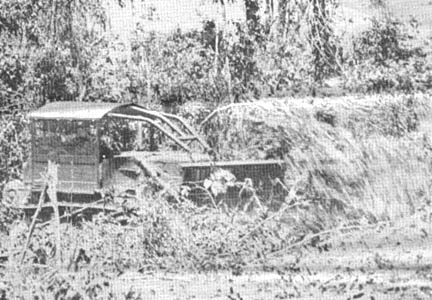 |
CLEARING - A Rome Plow clears the HoBo Woods. The 65th Combat Engineer Battalion has joined with infantrymen to search out the elusive enemy. (Photo by PFC George Pullen) |
Air Strikes Said To Be Ex-VC Maker
Ex-Viet Cong who rally to the government side often describe jet
air strikes as the VC's greatest fear. A recent example shows why.
In a single fourteen minute period during a 25th Inf Div operation
northwest of Saigon, Air Force 1LT Ronald Nagy a 2d Bde forward air controller,
put thirty-six 750 pound bombs on a Viet Cong bunkerline.
The total weight, equal to thirteen automobiles, added up to 27,000
pounds of high explosives, or slightly more than thirty-one pounds per second.
Enough to make any Viet Cong rally.
His Hideout Couldn't Be Any Worse
"Wolfhounds" of the 2d Bn, 27th Inf, are still scratching their
heads over a Viet Cong soldier's choice of hiding places.
Sweeping through the monsoon-flooded rice paddies northwest of
Saigon the unit's Alpha Co spotted a lone thatched hut right in the center of
the largest paddy around.
"I didn't figure a VC would be dumb enough to hide there, but
we went to check it out anyway," said PFC Santiago DeHoyos of Plainview, Tex.
As DeHoyos rounded a corner of the building, a Viet Cong soldier
loaded with Chinese grenades and RPG-2 anti-tank rounds looked him straight in
the eye. The enemy soldier spun and the U.S. rifleman fired, killing the
VC.
DeHoyos says things happened so quickly he hardly had time to
think, but he's still wondering why the Viet Cong chose probably the worst
hiding place in Hau Nghia Province.
Thanks to
Charles R. Wiggs, 25th Aviation Bn. for sharing this issue,
Ron Leonard, 25th Aviation Bn. for locating and mailing the issue,
Kirk Ramsey, 2nd Bn., 14th Inf. for creating this page.
This page last modified 8-12-2004
©2004 25th Infantry Division Association. All rights reserved.